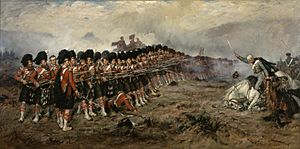The Thin Red Line (Battle of Balaclava) facts for kids
Quick facts for kids Thin Red Line |
|||||||
|---|---|---|---|---|---|---|---|
| Part of Battle of Balaclava, Crimean War | |||||||
 The Thin Red Line, painted by Robert Gibb |
|||||||
|
|||||||
| Belligerents | |||||||
|
|
|||||||
| Commanders and leaders | |||||||
| Strength | |||||||
| 500 Highlanders and 350 Turkish forces | 400 Russian forces | ||||||
The Thin Red Line is a famous event from the Battle of Balaclava. This battle happened on October 25, 1854, during the Crimean War. In this event, about 500 soldiers from the 93rd Sutherland Highlanders faced a large Russian cavalry attack.
These Scottish soldiers, led by Sir Colin Campbell, stood their ground. They were helped by a small group of 100 injured soldiers and 40 Guardsmen. Some Turkish soldiers also supported them. Together, they formed a strong line to stop the Russian cavalry.
Before this, Campbell's Highland Brigade had fought in the Battle of Alma and the Siege of Sevastopol. Many Victoria Crosses, which are awards for bravery, were given to Highland soldiers at that time. This event became very famous in Britain. It showed how brave British soldiers were, even though the war was not going well.
Contents
The Battle of Balaclava
This part of the battle happened early in the morning. A large Russian cavalry force, about 2,500 strong, was moving towards the British camp. Around 400 Russian soldiers were directly involved in this specific clash. The only soldiers standing between the Russian cavalry and the important port of Balaclava were the 93rd Regiment.

Sir Colin Campbell told his men, "There is no retreat from here, men. You must die where you stand." His aide, John Scott, replied, "Aye, Sir Colin. If needs be, we'll do that." Usually, soldiers would form a square shape to defend against cavalry. But Campbell felt his men were not trained enough for this.
Instead, he arranged the 93rd Regiment into a line that was only two soldiers deep. This was very unusual, as four soldiers deep was the normal way. This two-deep line became known as the "thin red line." As the Russian cavalry got closer, the Turkish soldiers on the sides ran away. The 93rd Regiment fired their guns twice. They fired once when the Russians were about 800 yards away and again at 500 yards. The Russians then turned away and did not charge the line directly.
Some historians, like George T. Denison, believe the Russian cavalry never planned to charge. He thought they were just trying to see how the British would react. When the 93rd showed their line, the Russians had seen what they wanted and left.
How the Term Became Famous
William H. Russell, a reporter for The Times newspaper, saw the event. He wrote that he could see nothing between the charging Russians and the British base except a "thin red streak tipped with a line of steel" of the 93rd Regiment. Later, he changed this phrase to "thin red line."
This phrase quickly became a symbol for the entire British Army. It meant a small group of soldiers bravely holding their ground against a much larger enemy.
The battle is shown in a famous oil painting from 1881 by Robert Gibb, called The Thin Red Line. You can see this painting at the Scottish National War Museum in Edinburgh Castle. There is also a painting of this event at Campbell's old school, High School of Glasgow. It honors him as one of the school's two famous generals.
Meaning of "The Thin Red Line" Today
The phrase "the thin red line" is now an figure of speech in English. It means any small military group that holds strong against an attack. It can also mean the limited armed forces of a country that protect it from enemies.
The term "the thin red line" later referred to the Argyll and Sutherland Highlanders. This regiment was formed by combining the Argylls and Sutherlands. Their job was to defend the British Empire and the United Kingdom.
The famous writer Rudyard Kipling used the phrase in his poem Tommy. He wrote: "Then it's Tommy this, an' Tommy that, an' Tommy, 'ow's yer soul? / But it's 'Thin red line of 'eroes' when the drums begin to roll." "Tommy Atkins" was a nickname for a common British soldier.
The term has also been used for other groups. For example, "the thin red line" can refer to the fire brigade. This is similar to "the thin blue line" which refers to police officers. You often see these phrases on bumper stickers in the US, showing support for police and fire departments.
The American writer James Jones wrote a novel called The Thin Red Line. It was about American soldiers fighting in Guadalcanal during World War II. This book was later made into two movies, one in 1964 and another in 1998.
See also

